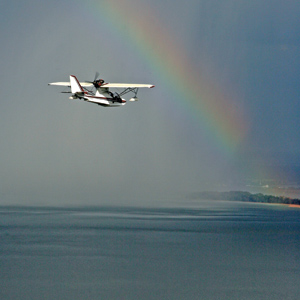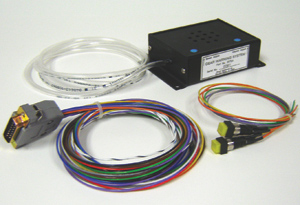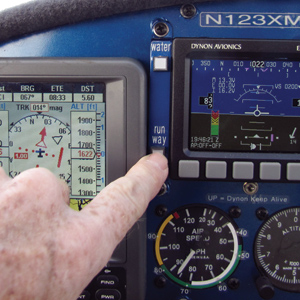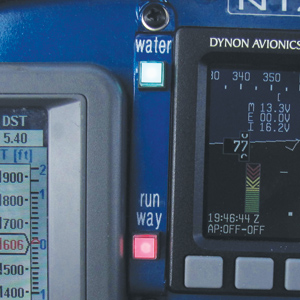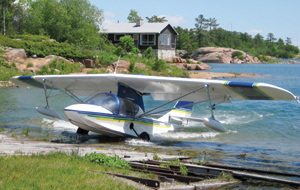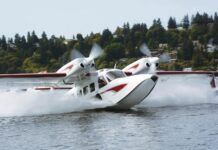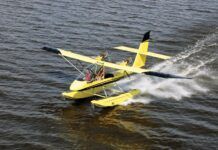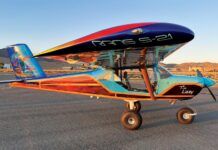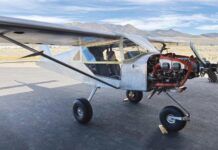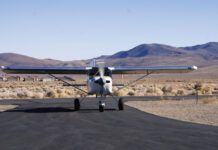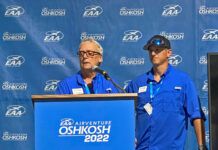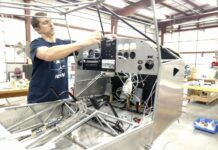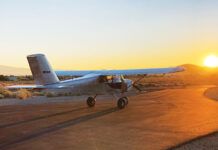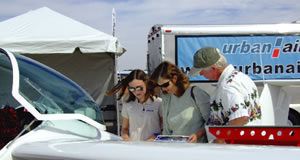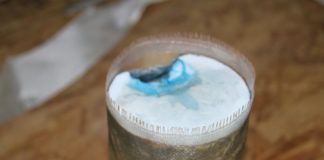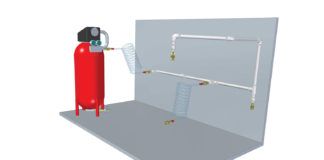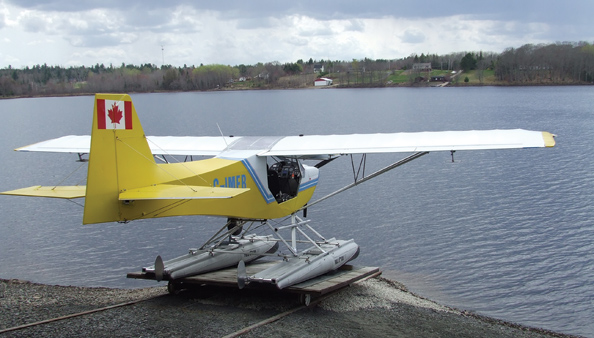
Mervin Zinck lives in New Germany, Nova Scotia. To put that in perspective, the town is a couple of miles farther south than the latitude of Bangor, Maine. (Interesting note: Maine extends farther north than does Nova Scotia.)
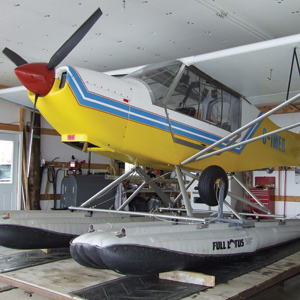
With the land wheels retracted above the floats, Zinck’s RANS is ready for the water.
Because New Germany Lake, located at the western edge of the village, is about a half mile from his home, Zinck had decided at the outset to fit his project with floats. He completed his RANS S-7S Courier—fitted with Full Lotus floats—in six months, and had it on the water in June of 2008. He built a hangar at the edge of the lake to take advantage of the location. He figured there was no sense traveling great distances to get to an airfield when only a minute or so would have him at the hangar. The Maritime Provinces are blessed with thousands of freshwater lakes, so there was no shortage of places to visit.
Like many homebuilders, Zinck is a craftsman in his own right. He owns a construction company that he built up from a single vehicle more than 30 years ago. One of his hobbies is the restoration of antique automobiles and farm machinery. He has the room, the tools and the skills to trade upon.
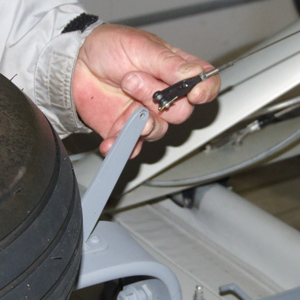
This tang allows both the retraction and deploying of the gear on its side of the airplane.
Preferences Change
While flying his S-7S off of water during his first 16 months Zinck discovered dozens of airstrips around Nova Scotia and the nearby provinces of New Brunswick and Prince Edward Island that he could land on—but only if he had wheels. This posed a problem. He had floats, which he would have to sell (probably at a loss) so that he could reinvest in amphibious floats in addition to incurring the extra cost of the retractable gear. Zinck wondered if it would be possible to convert his conventional floats into amphibious floats.
In February of 2010, he had an idea. He began drawing up plans for a set of retractable gear that could be quickly attached to the Full Lotus floats without too many time-consuming attachments or linkage points. By April he had come up with his own design, and the gear construction was completed. The rear wheels are fixed and self-castering, while the maingear is retractable and steerable with independent, hydraulically activated disk brakes.
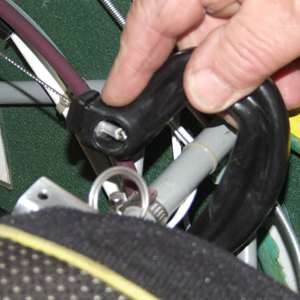
This plastic hook simply shows the gear is up. It can be seen through either window. Pulling toward you when the gear is down brings it up. There is a hook on each side of the cabin, one for each maingear wheel.
Gear of Steel
The maingear is constructed of T1 steel. There is a channel bracket on each unit that fits over and sandwiches the outer longitudinal tubular stiffener on the top of each float. This is held in place by four quarter-inch stainless-steel bolts drilled through the channels and the stiffeners. Each is spread to keep the holes separated so as not to weaken the stiffener.
A transverse built-up, steel channel—welded to the outer stiffener bracket—spans the inner and outer stiffeners with a single bracket gripping the inside longitudinal stiffener. This too is attached with two stainless-steel bolts through the inner float stiffener. The outside stiffener takes most of the weight when landing. Because the channel and fastener are situated between the float struts, it is a secure hard-point area in which to attach. Any torque tendency when the wheel is down and bearing the aircraft’s weight would be offset by the cross channel and its secure position on the inside stiffener. In effect, the outer stiffener is being lifted, but that is offset with the downward pressure on the inner stiffener, all of which is in the short span between the main hull/float struts. It is very strong.
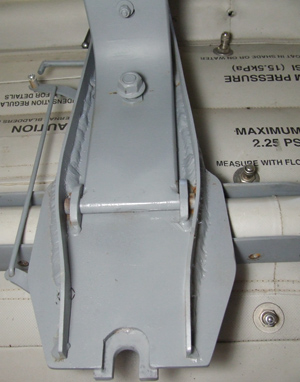
This close-up of the channel bracket, as it would be with the wheels in the “Up” (water) configuration, shows the sliding lock-down slot (far left) used to keep the wheels in the “Down” position.
This cross brace also supports the hinge upon which the gear struts swing up and down and under which slides the lock-down mechanism. When the gear is up, part of it sits right down in the channel.
The gear legs themselves are constructed of half-inch spring steel obtained from a local shop. They are bent to 90° and fitted with axles, rotors and disk brakes. The two maingear wheels are 6.00×6. Zinck used the bigger tires in anticipation of landing on grass strips and rough runways. Each retractable unit weighs 29.4 pounds. The two rear wheels, the cables and attachment bolts account for the balance of the weight, totaling 69.3 pounds.
Zinck’s floats might be marginally heavier than fully amphibious floats (he isn’t sure), but his can be detached at will, whereas integrated landing gear is in there for the long haul.
The maingear is right on the center of gravity and between the float bracing struts, and it’s at the strongest point. Zinck says that because his airplane is built to factory specifications, given the same airplane and same floats, there should be no need to fiddle with the location of the attachments on other RANS S-7S aircraft.
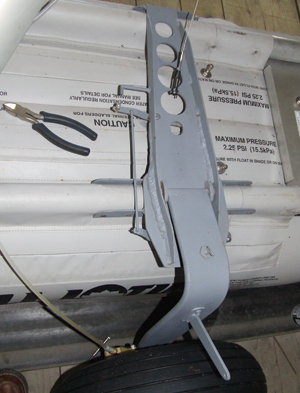
The maingear cradle bolts to the supporting beams on the Full Lotus floats. The pivot point is just above the outboard structural member.
Dear Operator
The gear is retracted by a cable. Once in the “Up” position, each retracted cable has a hook in the cockpit that hooks over a stud clamped to the tube airframe at the front of the seat. There is one of these cables on each side. The units are deployed using that same cable—a separate “pull down” cable is not necessary, because when the main cable is pulled up, the gear comes up and then goes over center and lies in the locked position. The tang on which the cable is attached is now angled downward. Pulling up on that cable lets it flip back over the center point and deploy outward. The gear is then locked down with the same cable that enables the locking mechanism. The locked-up and locked-down mechanism (a sliding latch) is employed for both positions. It is an ingenious system.
Zinck reports that he feels little weight when pulling each gear up, because once it reaches the over-center point, each falls into its retracted position on the float. He deploys or retracts one gear leg at a time—one hand to fly the airplane—so I asked him if the airplane slewed when he pulled one gear up or put one down. “Not really,” he said. “It’s still hanging out there in the breeze, so whether it’s up or down doesn’t make much difference.”
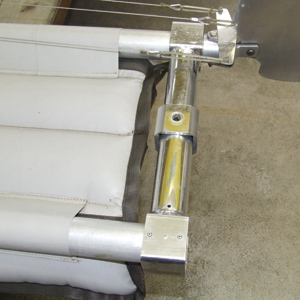
The rear float spreader was modified to strengthen and receive the tailwheel.
Coming up with a working braking system was a problem that Zinck had to overcome. Because the rear wheels are castering, in effect this is a taildragger on amphibious floats, and as a result, steering is accomplished via differential braking of the maingear. The connection of conventional brake lines on removable gear without the problem of having to connect the brake lines to a wet system that would require a laborious process of bleeding each side wouldn’t work, disregarding the fact that it is a messy business.
Zinck searched for and obtained connectors from a supplier in the United States. [Google “dry break couplings” to find suppliers near you.—Ed.] These allow the brake lines to be permanently filled with fluid and pressurized while the corresponding nylon brake line on each unit remains pressurized. When the nylon line is connected via a quick-lock to the male receptor on the fuselage, the little piston in the fuselage brake line presses on the receiver on the end of the maingear unit line; it transfers that energy to the brake fluid in the gear line, thereby activating the pads on the disk brake. Because both are sealed, there is never any need to bleed air—or fluid—from the line except when initially charging the brake lines during the construction process.
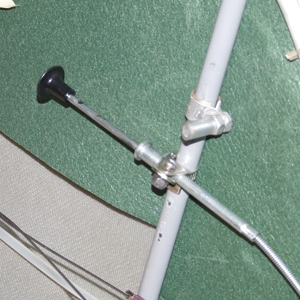
This is your downlock cable. It engages the sliding slot to make sure the gear stays down.
Speed Penalty?
When asked about extra drag, Zinck explained, “The turbulence coming over the front of the floats pretty much does away with that. The disturbed air doesn’t really leave much to create drag.”
He put 11⁄4-inch thick nylon shims under the two rear attachments on each float, raising the front of the floats and thereby increasing their angle of attack. He says it gives him a better cruise, because they are lifting rather than slightly hanging and adding drag. This also gets the tailwheels down a bit sooner during the landing flare. These are pneumatic tires held in place with a lock nut through-bolted through remanufactured tubing that was substituted for the original rear float spreader to strengthen it and to overcome any twisting moment or torque imparted during landings. The wheels are small enough that their drag potential in water is low when taking off. Zinck says he doesn’t even notice it, and because they are way behind the center of gravity, they don’t affect the touchdown on water.
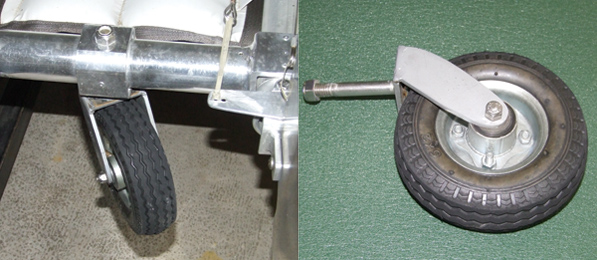
At the rear of each float is a free-castering tailwheel. Note: This photo shows the wheel mocked up; we know there aren’t enough threads showing through the lock nut.
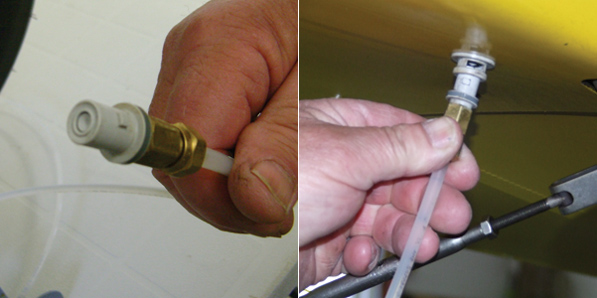
A “dry break” connector makes it possible to remove the wheels without having to open up the hydraulics.
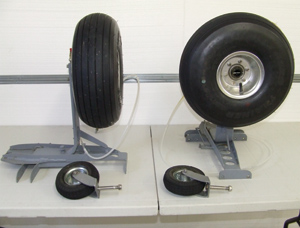
The final wheel assemblies before installation. To improve flotation on rough ground, Zinck chose a 6.00×6 tire.
At time of this writing, Zinck had accomplished 66 takeoffs and as many landings with no signs of stress or fractures. “I overbuilt them to begin with for that very reason,” he said. On hard surfaces the rear wheels keep the floats clear of the pavement, while on grass they keep the float elevated; the Kevlar float bottoms barely notice the sod.
Zinck has it in mind to market his design and have the gear and attachments built under license by a local manufacturer. He hasn’t fully worked out the details, but he has registered the design. He can be reached at 902-644-2327.
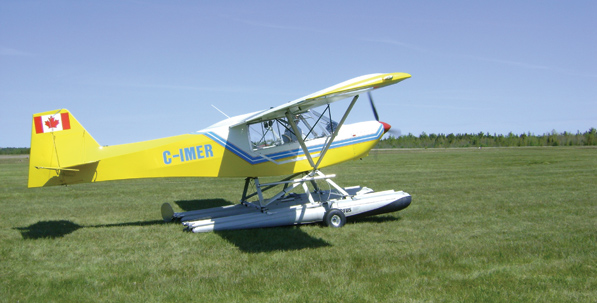
Zinck’s RANS is now at home on the water and on the turf.


